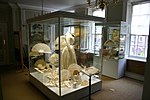Greenwich Tavern
LGBT culture in LondonPubs in the Royal Borough of GreenwichUse British English from March 2023

The Greenwich Tavern (formerly the Gloucester Hotel and Gloucester Arms, among other names) is a pub located at 1 King William Walk in Greenwich, London, opposite the northern entrance to Greenwich Park. In 2023 it became the third London location with a rainbow plaque denoting a significant place in LGBTQI+ history, being the location of a key scene in the 1996 film Beautiful Thing.
Excerpt from the Wikipedia article Greenwich Tavern (License: CC BY-SA 3.0, Authors, Images).Greenwich Tavern
King William Walk, London East Greenwich (Royal Borough of Greenwich)
Geographical coordinates (GPS) Address Nearby Places Show on map
Geographical coordinates (GPS)
| Latitude | Longitude |
|---|---|
| N 51.47985 ° | E -0.00718 ° |
Address
King William Walk 1
SE10 9JH London, East Greenwich (Royal Borough of Greenwich)
England, United Kingdom
Open on Google Maps









